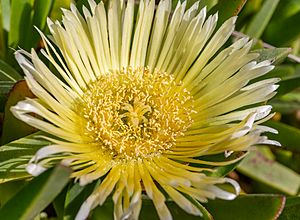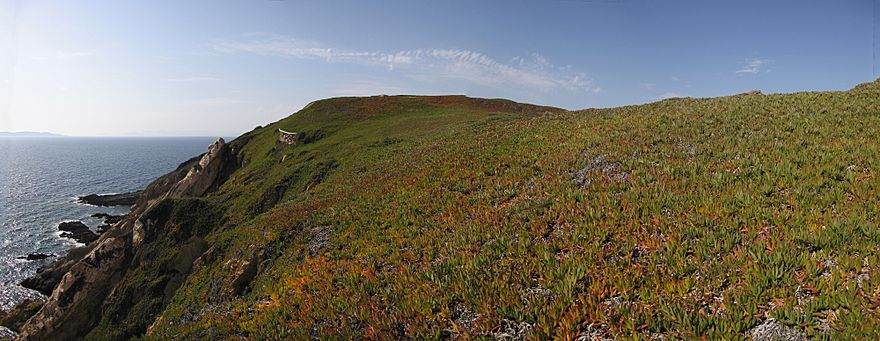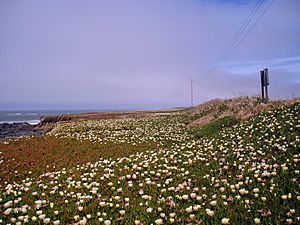Hottentot-fig facts for kids
Quick facts for kids Hottentot-fig |
|
|---|---|
 |
|
| Flower of Carpobrotus edulis | |
| Scientific classification | |
| Genus: |
Carpobrotus
|
| Species: |
edulis
|
| Synonyms | |
|
Mesembryanthemum edule L |
|
The Carpobrotus edulis is a plant that grows along the ground. It has thick, juicy leaves, like a succulent plant. This plant is originally from South Africa. People often call it the hottentot-fig, sour fig, ice plant, or highway ice plant.
Contents
What the Plant Looks Like
The Carpobrotus edulis is a plant that spreads out like a mat on the ground. It has thick, juicy leaves. It grows all year long, with new parts of the plant stretching over 1 meter (3 feet) each year. It can spread out to cover an area at least 50 meters (165 feet) wide. Its leaves are a dull green or yellowish-green color. They are only slightly curved and have tiny saw-like edges near their tips.
Its yellow flowers appear from April to October. They are quite large, ranging from about 6.4 to 15.2 centimeters (2.5 to 6 inches) across. The flowers open in the morning when the sun is bright and close at night. The fruit has many small sections and changes from green to yellow when it ripens.
This plant can sometimes be confused with its close relatives. One such relative is the Carpobrotus chilensis, also called the sea fig, which is smaller and less aggressive. The two plants can easily create hybrids (mixed plants). However, you can usually tell C. edulis apart by its larger, yellow flowers. The C. chilensis has smaller flowers, about 3.8 to 6.4 centimeters (1.5 to 2.5 inches) wide, and they are a deep pink-purple color.
How it is Classified
The Carpobrotus edulis belongs to the fig-marigold family, called Aizoaceae. It is one of about 30 different types of plants in the Carpobrotus group. It used to be called Mesembryanthemum edule.
Where it Grows Naturally
The sour fig plant grows on slopes near the coast and further inland in South Africa. You can find it from Namaqualand in the Northern Cape all the way through the Western Cape to the Eastern Cape. It often grows first in places where the ground has been disturbed, like after a fire or construction.
How it Interacts with Nature
The flowers of the Carpobrotus edulis are pollinated by different kinds of bees, like solitary bees, honey bees, and carpenter bees. Many types of beetles also help pollinate them. Tortoises eat the leaves of the plant. Antelopes and baboons eat the flowers. The fruits are eaten by baboons, rodents, porcupines, and antelopes, which helps spread the seeds around.
The thick clumps of the plant provide shelter for snails, lizards, and skinks. Snakes like Puff adders and the Cape cobra are often found hiding in these plant clumps. They wait there to catch small rodents that are attracted to the fruits.
When it Becomes an Invasive Species
Carpobrotus edulis has started growing naturally in many other parts of the world. It is considered an invasive species in several places, especially in Australia, California, and around the Mediterranean Sea. These areas have climates similar to South Africa. The ice plant has escaped from gardens and is now causing serious problems for the environment. It forms huge areas where only this plant grows, which lowers the number of different plant and animal species (called biodiversity). It also takes away nutrients, water, light, and space from other plants, including some rare or endangered ones.
Ireland
This plant has been found growing wild in County Down, in the south and east of Ireland, and on the cliffs of Howth Head in County Dublin. It likely escaped from gardens.
Mediterranean
Along the Mediterranean coast, Carpobrotus has spread very quickly. Now, large parts of the coastline are completely covered by it. Interestingly, another invasive species, the black rat, helps the ice plant spread even more through its droppings. Since the ice plant is a food source for the rat, both species benefit from each other. This is called invasive mutualism, where two species help each other, but in a way that harms the local environment.
New Zealand
In New Zealand, the ice plant forms large areas where only it grows. It has taken over huge parts of the coastal sand dune ecosystem. C. edulis and its mixed types are considered unwanted organisms. They are listed on the National Pest Plant Accord, which means they are plants that should be controlled.
United States
The ice plant might have arrived in the US by ship as early as the 1500s. However, it was actively brought to California in the early 1900s to help hold sand dunes and soil in place along railroad tracks. Later, the California Department of Transportation (Caltrans) used it to cover ground along freeway slopes. Thousands of acres were planted in California until the 1970s.
The plant spreads easily from its seeds (hundreds in each fruit) and from pieces of its shoots (any part of a shoot can grow roots). Its thick, juicy leaves, bright yellow flowers, and ability to handle harsh coastal weather (like salt) also made it a popular garden plant. For many decades, the ice plant was widely promoted as an ornamental plant, and you can still find it in some plant nurseries. Its leaves can turn a bright red to yellow color.
Even though it was used to stabilize soil, it actually makes coastal erosion worse and faster. Its leaves hold a lot of water, and its roots are very shallow. During the rainy season, the extra weight on unstable sandstone slopes and dunes increases the chance of the slopes collapsing and causing landslides.
The ice plant is still common along highways, beaches, on military bases, and in other public and private areas. It spreads beyond planted areas and has invaded sand dunes, coastal scrub, coastal prairies, and even some chaparral communities. In California, the ice plant is found in coastal areas from north of Eureka down to Rosarito in Baja California. It cannot handle frost, so it doesn't grow far inland or at elevations higher than about 150 meters (500 feet).
The plant flowers almost all year round. It starts in February in southern California and continues until autumn in northern California. Flowers are usually present for at least a few months in any given area.
Removing the Plants
You can try to control ice plants by pulling them out by hand. You can also use earth-moving machines like a skid-steer or tractor. However, it's important to remove any buried stems and cover the soil with mulch to stop them from growing back. For chemical control, special weed killers called glyphosate herbicides are used. Because the plant's shoots contain a lot of water, burning live or dead plants is not a good way to control or get rid of them.
Growing the Plant
The Carpobrotus edulis needs soil that drains well, a sunny spot, and plenty of room to spread out. It is an excellent plant that stays green all year. It can handle dry weather and strong winds. You can plant it on flat, sandy ground, loose sand dunes, lime-rich soils, salty soils, and gravelly gardens. It also grows well in containers, rock gardens, and on slopes, and will hang down over walls.
What it is Used For
The fruit of the C. edulis is edible, just like some other plants in the Aizoaceae family. Its leaves can also be eaten. In South Africa, the ripe fruits of the sour fig are collected and eaten fresh. They are also made into a very tart jam.
Different parts of the C. edulis plant are used in traditional medicine, mostly in South Africa. People often eat the fruits and flowers raw or cooked to help with fungal and bacterial infections. The leaves can be eaten to help with digestive problems, or the juice can be sucked out to soothe a sore throat. The juice can also be mixed into a lotion and used on the skin for issues like ringworm, bruises, sunburns, and cracked lips.
See also
 In Spanish: Carpobrotus edulis para niños
In Spanish: Carpobrotus edulis para niños




